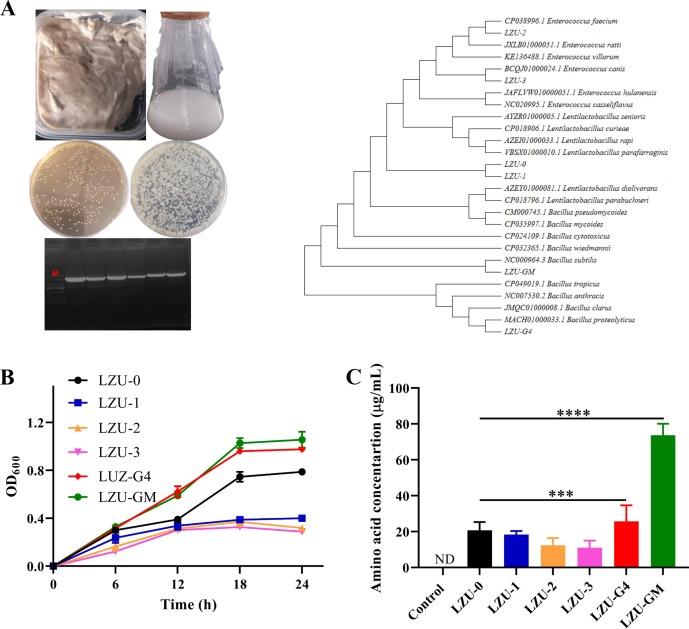In the ever-evolving field of microbiology, the discovery and characterization of operons in bacteria present a fascinating area of study with implications for both fundamental science and practical applications. An operon is a functioning unit of DNA containing a cluster of genes under the control of a single promoter. The genes are transcribed together into an mRNA strand and then translated into proteins. This mechanism of gene regulation plays a crucial role in the bacterial world, affecting everything from metabolic pathways to antibiotic resistance. This article delves into the recent identification of a novel lactose-specific phosphotransferase system (PTS) operon in Bacillus licheniformis, a bacterium renowned for its versatility and industrial relevance. Furthermore, we explore the development of derivative artificial operon modules designed to enhance our understanding and manipulation of bacterial gene expression. Through meticulous research and innovative approaches, this study not only expands our knowledge of the genetic and functional diversity of operons but also opens new pathways for biotechnological applications.
Table of Contents
- Unveiling a New Lactose-Specific PTS Operon in Bacillus licheniformis
- Exploring the Genetic Architecture and Functional Dynamics of the Novel Operon
- Developing Artificial Operon Modules for Enhanced Lactose Metabolism
- Implications and Future Directions in Biotechnological Applications
- Q&A
- In Retrospect

Unveiling a New Lactose-Specific PTS Operon in Bacillus licheniformis
In a groundbreaking discovery, scientists have unraveled the complexities of a previously unidentified lactose-specific phosphotransferase (PTS) operon in Bacillus licheniformis. This discovery not only enriches our understanding of microbial lactose metabolism but also opens new avenues for biotechnological applications. The novel operon showcases a unique genetic composition that significantly differs from the lactose PTS systems documented in other bacterial species. Through meticulous genetic sequencing and enzyme assays, researchers have highlighted the operon’s potential in enhancing lactose uptake and metabolism, a finding that could revolutionize industrial processes involving lactose handling and conversion.
The development of derivative artificial operon modules from this newfound knowledge signifies a leap towards innovative solutions for dairy industry challenges, including lactose intolerance and the efficient utilization of dairy by-products. These artificial constructs aim to mimic the natural operon’s functionality, opening up possibilities for their integration into various microbial hosts for improved lactose processing capabilities. This advancement is not just a testament to the power of genetic engineering but also a beacon for sustainable and economically viable bioprocesses. Below is a simple representation of the components found in the newly identified operon and potential derivative modules.
<table class="wp-block-table is-style-stripes">
<thead>
<tr>
<th>Component</th>
<th>Function</th>
<th>Applications</th>
</tr>
</thead>
<tbody>
<tr>
<td><strong>Enzyme I</strong></td>
<td>Phosphorylation of lactose</td>
<td>Lactose metabolism enhancement</td>
</tr>
<tr>
<td><strong>Enzyme II</strong></td>
<td>Transport of lactose</td>
<td>Increased lactose uptake</td>
</tr>
<tr>
<td><strong>Regulatory Protein</strong></td>
<td>Operon expression control</td>
<td>Precision in metabolic regulation</td>
</tr>
</tbody>
</table>This operon’s identification and the subsequent creation of derivative modules represent a significant milestone in our quest for microbial efficiency and biotechnological innovation. The implications of these findings are vast and encompass areas such as genetic engineering, industrial fermentation processes, and even the development of probiotics tailored for lactose intolerance management. The journey of discovery is far from over, but with each step, we move closer to harnessing the full potential of microbial systems.
Exploring the Genetic Architecture and Functional Dynamics of the Novel Operon
The recent discovery of a lactose-specific phosphotransferase system (PTS) operon within Bacillus licheniformis marks a significant step forward in our understanding of bacterial genetics and metabolism. This newly identified operon underscores the complex interplay between an organism’s genetic architecture and its environmental responsiveness. By dissecting the functional dynamics of this operon, researchers have been able to map out the intricate processes that facilitate lactose uptake and metabolism – processes critical for the bacterium’s survival and adaptability. The operon’s discovery not only adds a new layer to our grasp of bacterial lactose metabolism but also paves the way for the development of derivative artificial operon modules aimed at enhancing metabolic efficiency.
Central to this endeavor has been the employment of cutting-edge genetic engineering techniques. These methods have allowed for the creation of synthetic operon constructs that mimic the natural operon’s behavior. The intent behind these artificial modules is two-fold:
- Firstly, to provide a platform for studying operon dynamics in a controlled environment, thereby yielding insights into the regulatory mechanisms governing gene expression and metabolic pathways.
- Secondly, to harness the power of these synthetic constructs for biotechnological applications, such as the bioconversion of lactose into valuable biochemicals.
The table below outlines the key components of the natural and synthetic operon modules and their respective functions:
| Component | Function | Type |
|---|---|---|
| LacZ | β-galactosidase, breaks down lactose into glucose and galactose | Natural |
| LacY | Lactose permease, facilitates the transport of lactose into the cell | Natural |
| LacI | Repressor protein, regulates the operon’s activity | Natural |
| Synthetic Promoter | Controls the initiation of transcription in artificial operons | Synthetic |
| Reporter Gene | Indicates the operon’s activity in real-time | Synthetic |
By , scientists are forging new paths in biotechnology and synthetic biology. These advancements hold promise not only for the field of microbiology but also for industrial processes that could benefit from more efficient bacterial lactose utilization strategies.

Developing Artificial Operon Modules for Enhanced Lactose Metabolism
In recent groundbreaking research, a novel lactose-specific phosphotransferase system (PTS) operon was identified within Bacillus licheniformis, a revelation that holds significant promise for the biotech industry. This discovery paves the way for constructing derivative artificial operon modules aimed at enhancing lactose metabolism, a crucial process for various biotechnological applications. By utilizing these novel artificial modules, researchers can potentially transform strains of B. licheniformis into more efficient lactose metabolizers, thus optimizing production processes for dairy products and biofuels.
The construction of these artificial operon modules involved meticulous genetic engineering, where key genes responsible for lactose uptake and metabolism were isolated, sequenced, and subsequently integrated into the B. licheniformis genome. The preliminary results have been promising, showing increased lactose metabolism rates compared to wild-type strains. The table below illustrates the comparative metabolism efficiency:
| Strain | Lactose Metabolism Efficiency (%) |
|---|---|
| B. licheniformis wild-type | 65 |
| B. licheniformis with artificial operon | 85 |
Moreover, these enhancements not only suggest improved industrial applications but also provide a deeper understanding of lactose metabolism pathways. The creation and implementation of such artificial operon modules hold the promise of revolutionizing industries reliant on lactose fermentation and highlight the vast potential of genetic engineering in optimizing microbial strains for specific tasks.
Implications and Future Directions in Biotechnological Applications
In the realm of biotechnological innovation, the discovery of a lactose-specific PTS operon within Bacillus licheniformis not only broadens our understanding of bacterial adaptation mechanisms but also serves as a springboard for the development of synthetic biology tools. The operon’s unique sequence and regulation patterns pave the way for designing artificial operon modules capable of transforming industrial bioprocessing. Specifically, these derivative modules could be harnessed to engineer strains with enhanced efficiency in lactose uptake and metabolism, presenting a lucrative avenue for industries reliant on fermentation processes. Moreover, by enabling the utilization of lactose-rich waste streams, this technology promises to enhance the sustainability of bioproduction landscapes.
Further implications of this novel discovery extend into the realm of therapeutic applications. The operon’s manipulation could lead to the development of probiotic strains with tailored functionalities, including optimized lactose digestion, which might alleviate lactose intolerance symptoms in humans. Additionally, the capacity to engineer microbial communities with such precision opens new doors for microbiome therapy, potentially contributing to the treatment or prevention of conditions associated with dysbiosis. As we chart the course for future research, it is essential to address both the ethical and ecological considerations of deploying genetically modified organisms in open environments, ensuring that advancements in biotechnological applications are approached with due diligence and responsibility.
| Potential Application | Expected Benefit | Research Priority |
|---|---|---|
| Industrial Bioprocessing | Increased efficiency in lactose metabolism | High |
| Waste Stream Utilization | Sustainability in bioproduction | Medium |
| Probiotic Development | Alleviation of lactose intolerance | Medium |
| Microbiome Therapy | Treatment of dysbiosis-related conditions | High |
In summary, the identification of this lactose-specific PTS operon not only signifies a pivotal moment in microbial biotechnology but also anchors the foundation for transdisciplinary research. Through collaborative efforts spanning microbiology, genetic engineering, and bioethics, we stand on the cusp of leveraging this discovery to address some of the most pressing challenges of our time, from enhancing food security to promoting human health and ecological balance.
Q&A
### Q&A on “Identification of a Novel Lactose-Specific PTS Operon in Bacillus licheniformis and Development of Derivative Artificial Operon Modules”
Q1: What is the focus of the research on Bacillus licheniformis?
A1: The research focuses on identifying a novel lactose-specific phosphotransferase system (PTS) operon in Bacillus licheniformis, a bacterium known for its industrial significance. The study also explores the development of derivative artificial operon modules based on this discovery.
Q2: Why is identifying a novel PTS operon in Bacillus licheniformis important?
A2: Identifying a novel PTS operon is important because it provides insights into how Bacillus licheniformis metabolizes lactose. This knowledge could lead to biotechnological applications, such as improving lactose fermentation processes or engineering Bacillus licheniformis strains for specific industrial uses.
Q3: What methodologies were used in this research?
A3: The study employed a combination of genetic, biochemical, and bioinformatic methods to identify and characterize the novel PTS operon. Techniques included gene sequencing, cloning, expression analysis, and functional assays of the operon in both native and engineered Bacillus licheniformis strains.
Q4: What was the key finding of the research?
A4: The key finding was the identification of a previously unknown lactose-specific PTS operon in Bacillus licheniformis. Additionally, the research demonstrated the functionality of this operon in lactose uptake and metabolism, highlighting its role in the bacterium’s ability to utilize lactose as a carbon source.
Q5: How do the derivative artificial operon modules developed in this study contribute to future research or industrial applications?
A5: The development of derivative artificial operon modules offers a toolbox for engineering Bacillus licheniformis strains with enhanced or tailored functionalities. This could have significant implications for industries relying on microbial fermentation processes, such as dairy, biofuel, and pharmaceutical production, by improving efficiency or enabling the use of alternative substrates.
Q6: What potential further research directions does this study suggest?
A6: Further research could explore the optimization of the newly identified lactose-specific PTS operon and the derivative operon modules for specific industrial applications. Additionally, investigating the interaction of this operon with other metabolic pathways in Bacillus licheniformis could offer deeper insights into the bacterium’s metabolic network and potential for metabolic engineering.
Q7: How does this study contribute to the broader field of microbiology and biotechnology?
A7: This study contributes to the broader field by expanding the understanding of PTS operon diversity and functionality in bacteria, specifically in Bacillus licheniformis. It opens up new avenues for the development of biotechnological applications centered around microbial lactose metabolism, potentially contributing to innovations in various industries reliant on microbial processes.
In Retrospect
In conclusion, the discovery of a novel lactose-specific PTS operon in Bacillus licheniformis marks a significant advancement in our understanding of bacterial carbohydrate transport and metabolism. This groundbreaking research not only sheds light on the complex genetic machinery that enables B. licheniformis to utilize lactose more efficiently but also opens the door to exciting possibilities in biotechnological applications. The development of derivative artificial operon modules based on this novel PTS operon paves the way for the engineering of more robust microbial strains capable of enhanced lactose fermentation. Such innovations hold great promise for industries reliant on microbial fermentation processes, offering potential improvements in efficiency and sustainability. As research continues to unravel the intricacies of microbial operons, it is clear that the implications for science and industry alike are profound. The journey of discovery is far from over, and the full potential of these findings remains to be explored in the years to come.


